The Niagara River is a river that flows northward from Lake Erie to Lake Ontario. The river forms part of the border between the Ontario province in Canada and New York in the United States. It is a natural drainage channel for the Great Lakes system, specifically connecting Lake Erie to Lake Ontario.
The Niagara River is approximately 58 kilometers (36 miles) long and has an average flow rate of about 5,700 cubic meters per second (200,000 cubic feet per second). It’s renowned for its iconic waterfalls, Niagara Falls, along its course. The river divides into two main sections: the Upper Niagara River and the Lower Niagara River.
Is It Safe to Swim in the Niagara River?
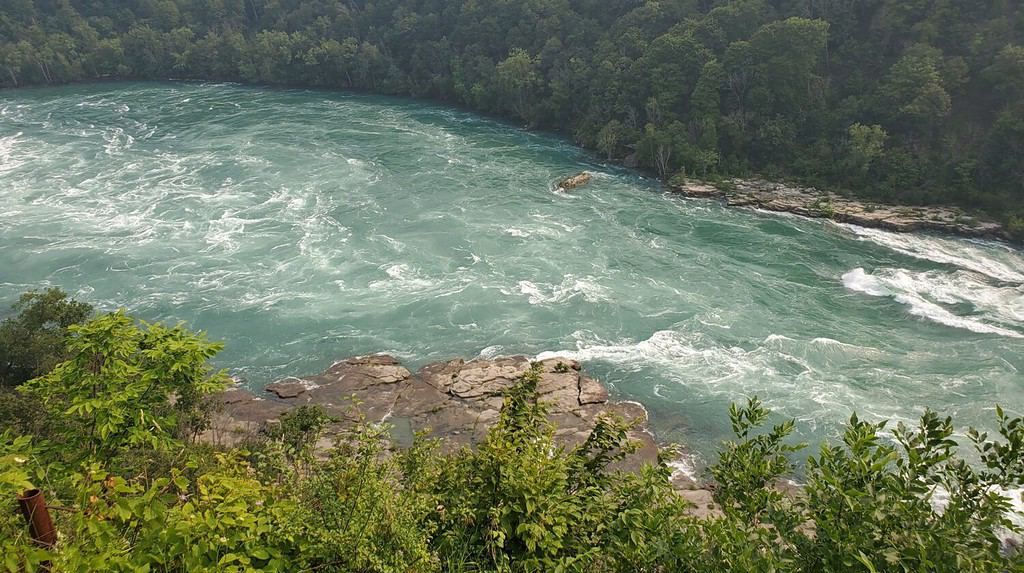
©RHartley/Shutterstock.com
Swimming in the Niagara River is not safe. The fast-moving waters have strong currents that can quickly sweep even the strongest swimmers downstream. Moreover, the river is home to dangerous whirlpools, eddies, and rapids that can be deadly even for experienced swimmers.
People do not recommend swimming in the Niagara River, nor is it allowed in most areas. The river has strong currents, turbulent rapids, and unpredictable undertows, especially in the Lower Niagara River below Niagara Falls. These conditions pose significant risks to swimmers, making them dangerous and potentially life-threatening.
Additionally, regulations and restrictions are in place for public safety and to preserve the natural environment. Authorities and park management agencies have implemented measures to prevent swimming in certain areas of the Niagara River.
Queens Royal Beach
Queens Royal Beach is the only public swimming beach on the Niagara River. Although it is safe from strong currents, rapids, and undertows, you still need to be careful swimming in the water due to water quality issues the beach faces. The Niagara River Remedial Action Plan uses beach water quality as an indicator of the overall health of the Niagara River as part of its goal to restore water quality and ecosystem health and thus remove it from the list of the Great Lakes Areas of Concern.
Other Swimming Areas Near the Niagara River
These designated swimming areas separate from the main channel of the Niagara River, where authorities strongly discourage swimming due to hazardous conditions. Always check local regulations and signs, and consult with official sources to ensure you know any safety guidelines and restrictions before swimming in these areas.
- Crystal Beach: Located on the Canadian side of Lake Erie, Crystal Beach offers a sandy beach and designated swimming areas. It is a popular spot for locals and tourists to enjoy swimming.
- Sunset Beach: Also on the Canadian side of Lake Erie, Sunset Beach in St. Catharines, Authorities permit swimming. It has a sandy beach and facilities for visitors.
- Woodlawn Beach State Park: On the American side of Lake Erie, Woodlawn Beach State Park in Hamburg, New York, offers a sandy beach and designated swimming areas. It is a popular destination for swimming, sunbathing, and picnicking.
- Lakeside Beach State Park: Located on the southern shore of Lake Ontario in Waterport, New York, Lakeside Beach State Park provides a sandy beach and designated swimming areas for visitors.
The Niagara River
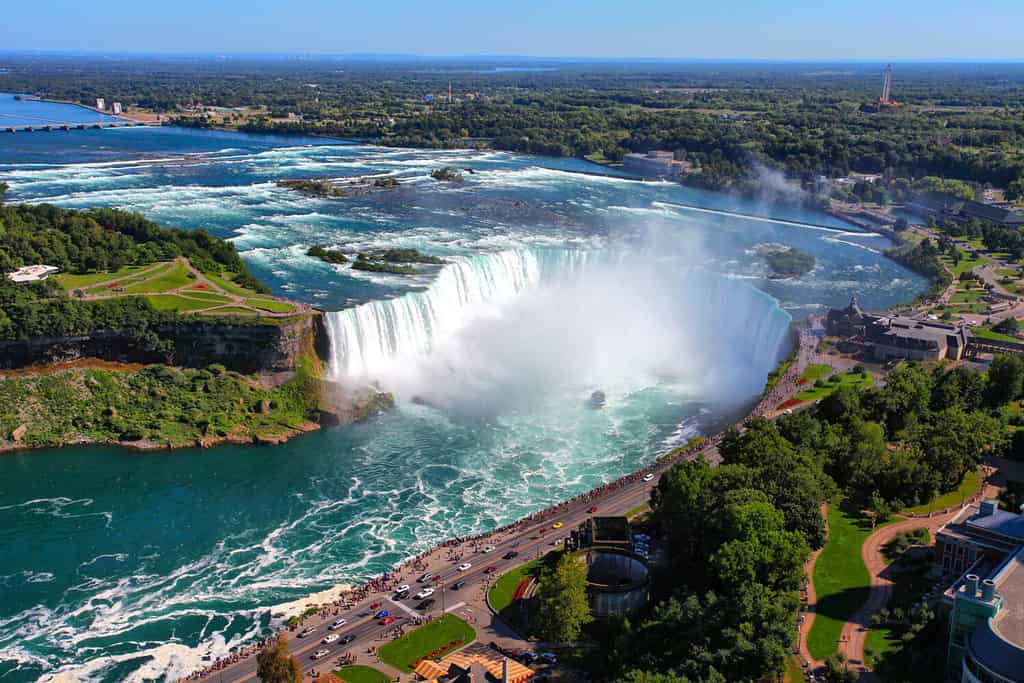
©Igor Sh/Shutterstock.com
The Niagara River is integral to Earth’s most extensive freshwater system: The Great Lakes Basin. This famous river is also an international waterway connecting Canada to the United States along its 58-km length.
The Niagara River contributes 83% of the water that flows into Lake Ontario, serving as a vital source of drinking water for millions of Ontario’s residents. In the Niagara Region, around 130,000 people depend on the Niagara River and Lake Ontario to meet their drinking water needs. Besides being essential for drinking water, the Niagara River has various other vital purposes. It provides a habitat for fish and wildlife, offers opportunities for recreational activities, serves as a source of power generation, and supplies water for industrial use.
The Upper Niagara
The Upper Niagara River extends from Lake Erie to the brink of Niagara Falls. It is relatively calm and popular for recreational boating and fishing.
The Lower Niagara
The Lower Niagara River starts at the base of the falls and flows to Lake Ontario, passing through the Niagara Gorge. People characterize this section of the river by turbulent rapids and whirlpools, attracting thrill-seekers and offering opportunities for activities like jet boating and whitewater rafting.
History of the Niagara River
The Ice Age and Niagara Falls
The Niagara River and the entire Great Lakes Basin are a testament to the geological legacy of the last Ice Age. Around 18,000 years ago, vast ice sheets several kilometers thick covered Southern Ontario. These advancing ice sheets sculpted the basins that now hold the Great Lakes. As the ice gradually receded northward, it unleashed vast meltwater into these newly formed basins. Roughly 12,500 years ago, the Niagara Peninsula emerged free of ice. With the ongoing retreat of the ice, the meltwaters began their course through what would eventually become Lake Erie, the Niagara River, and Lake Ontario. They ultimately flowed into the St. Lawrence River, reaching the Atlantic Ocean.
The Niagara River showcases a total descent of 99 meters along its course. Over the past 12,000 years, Niagara Falls has migrated approximately 11 kilometers upstream from the Niagara Escarpment. This movement resulted in the formation of a gorge below the falls, which includes the fascinating Niagara Whirlpool. The river also features two main islands, namely Grand Island on the American side and Navy Island on the Canadian side. Additionally, there are numerous smaller islands. Goat Island and the diminutive Luna Island divide Niagara Falls into three distinctive sections: the Horseshoe Falls, Bridal Veil Falls, and American Falls.
Onguiaahra
Early indigenous people discovered Niagara thousands of years ago. The Native Americans were the earliest people to reside in the Niagara region. During the early 1600s, an estimated 12,000 Native Americans inhabited the area, making them the most prominent Native group in the Northeast during the 17th century. Their territory spanned the western end of Lake Ontario and the northern shores of Lake Erie, encompassing both sides of the Niagara River. The Native Americans called this region Onguiaahra “the strait” or “thundering water.” The name Niagara originated from this Native word and came to symbolize the thundering waters themselves.
The Niagara River and the American Revolution
Recognizing the river’s significance for the fur trade and as a river passage, the French constructed Fort Niagara at its mouth in 1678. Control of the fort shifted to the British in 1759, and it served as a vital supply depot during the American Revolution. The Revolutionary War had two significant consequences: in 1783, the river became part of the boundary between British and American territories. Loyalists settled in this area to flee conflict.
The Niagara River and Power Generation
The Niagara River has a long history of power generation and industrial development. The advent of hydroelectric power harnessed from Niagara Falls spurred the growth of chemical industries along the American side of the river. As pollution levels escalated, drawing attention through well-publicized public health crises like the Love Canal, citizens, environmentalists, and politicians pressed for proactive measures to address the severe degradation of the Niagara River.
Niagara River Fun Facts
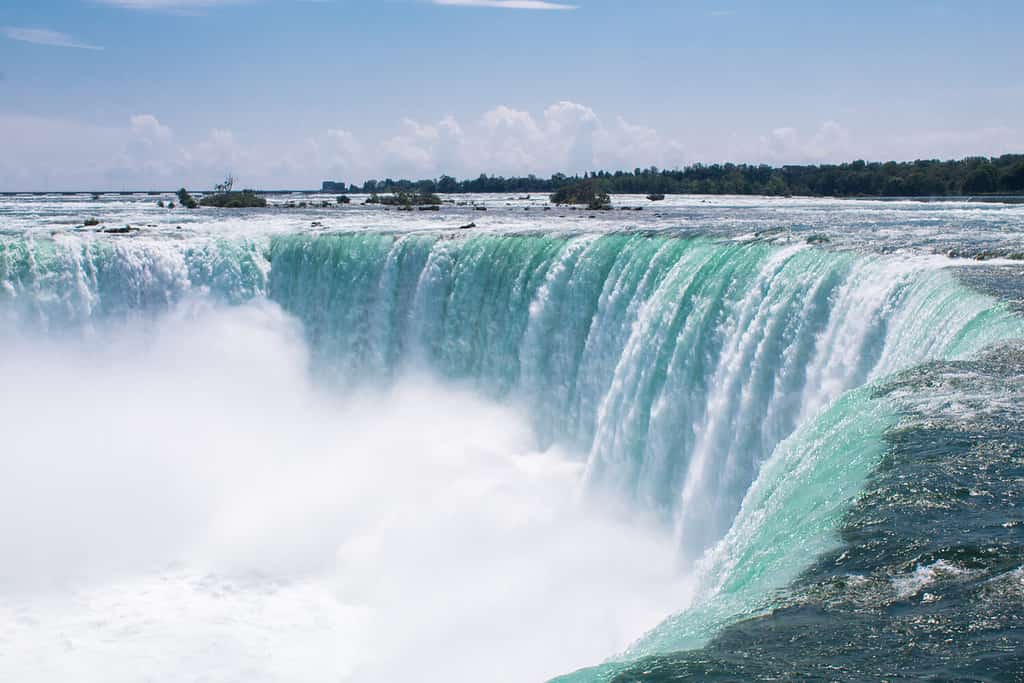
©aliciavf/Shutterstock.com
- The Great Lakes represent the world’s most extensive surface freshwater system: Lake Superior, Lake Huron, Lake Michigan, and Lake Erie. All of these lakes contribute their waters to the Niagara River.
- The Niagara River drains a vast area of approximately 684,000 square kilometers. It spans a length of 58 kilometers, flowing northward from Lake Erie to Lake Ontario. Then, connecting to the St. Lawrence River, ultimately reaching the Atlantic Ocean. The difference in elevation between Lake Erie and Lake Ontario amounts to 99 meters. Niagara Falls measures 52 meters in height.
- Over 500 waterfalls globally surpass Niagara Falls in height, such as Venezuela’s Angel Falls, which stands at 979 meters (3,212 ft.). Many of these falls have considerably less water flowing over them. What makes Niagara Falls genuinely stunning is the combination of its height and the tremendous volume of water. During peak daytime tourist hours, over 168,000 cubic meters (6 million cubic ft.) of water cascade over the falls every minute.
- Niagara Falls has undergone a significant recession, retreating 11.3 kilometers (7 miles) over 12,500 years. This potentially makes it one of the fastest-moving waterfalls on Earth.
- At Grand Island, the Niagara River divides into two channels: the west channel, known as the Canadian Channel, and the east channel, known as the American Channel. The Niagara Gorge stretches for 11 kilometers (7 miles). It continues downstream from the falls, reaching the foot of the escarpment at Queenston.
- The waters of the Niagara River serve the needs of a combined population of over 1,000,000. This includes the people in Canada and the United States for various purposes. Drinking water, recreational activities such as boating, swimming, bird-watching, fishing, industrial cooling water supply, and disposal all need Niagara. Hydroelectric power harnesses the river’s flow. The Sir Adam Beck Station in Ontario and the New York State Power Authority contributed to this effort.
What is the Niagara River Known for?
What makes Niagara Falls so impressive is the amount of water flowing over. The tallest falls in the world have very little water flowing over them. The combination of height and volume makes Niagara Falls so breathtaking.
Where Does All The Water Come From?
The Great Lakes is the most extensive surface freshwater system globally, encompassing approximately 18 percent of the world’s freshwater supply. If the water within the Great Lakes were evenly spread out, it would create a layer about 1 meter (3.5 ft.) deep across the entire expanse of North America!
The water originates from various streams and rivers that flow into the Great Lakes. This begins with Lake Superior and progresses through Niagara into Lake Ontario. From there, it continues its journey through the St. Lawrence River, ultimately reaching the Atlantic Ocean. While water typically flows downhill towards the sea, the unique characteristic of the Niagara River is that it flows northward, defying the norm.
Less than one percent of the water within the Great Lakes is renewed annually through precipitation (rain, sleet, snow, hail) and groundwater. Most water is considered “fossil” water, a remnant from the last ice age. Despite this, the Great Lakes sustain their water levels primarily due to consistent replenishment from precipitation and groundwater.
The brown foam observed below Niagara Falls is a natural consequence of the massive water plunging into the depths below. It is not hazardous. The brown coloration stems from clay particles containing suspended fragments of decomposed vegetation. The clay and organic matter predominantly originate from the shallow eastern basin of Lake Erie.
Fishing in the Niagara River
The Lower Niagara can be fished 12 months a year, with different opportunities each season. The river is renowned for its abundant fish population, making it a popular destination for fishing enthusiasts.
The Niagara River supports a variety of fish species, including but not limited to:
- Lake Trout: Known for their fighting spirit, lake trout can be found in the deeper sections of the river. They are prized catches for their size and delicious flesh.

Lake trout can be found in the deeper sections of the river.
©U.S. Fish and Wildlife Service / public domain – License
- Smallmouth Bass: The Niagara River is known for its excellent smallmouth bass fishery. Anglers can target these feisty and hard-fighting fish in the river’s rocky areas and around the structure.
- Chinook Salmon: Niagara River offers opportunities for anglers to target Chinook salmon, also known as king salmon. These powerful fish migrate from Lake Ontario into the river, providing thrilling battles for anglers.
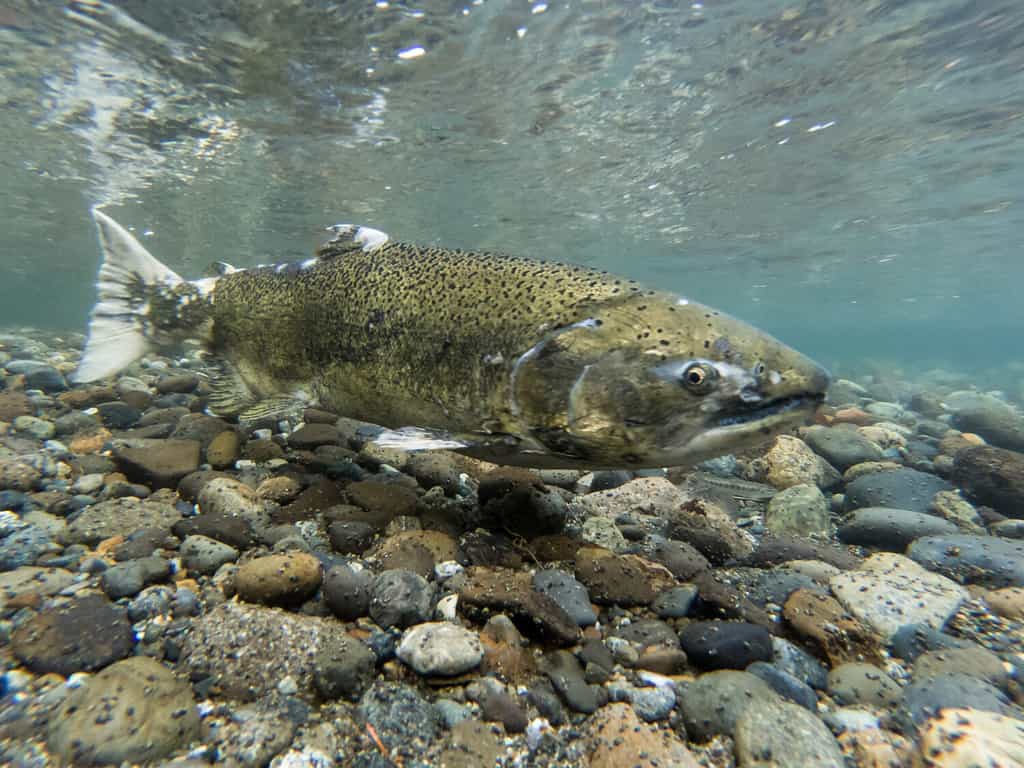
Chinook Salmon migrate from Lake Ontario into the river.
©Kevin Cass/Shutterstock.com
- Steelhead/Rainbow Trout: Steelhead, or rainbow trout, are prized for their acrobatic leaps and strong runs. They migrate into the Niagara River from Lake Ontario, particularly during the spring and fall, offering fantastic fishing opportunities.
- Walleye: The Niagara River is home to a healthy walleye population, attracting anglers seeking this highly sought-after game fish. Walleye can be found in various river sections and are known for their excellent taste.
Niagara Animals, Flora, and Fauna
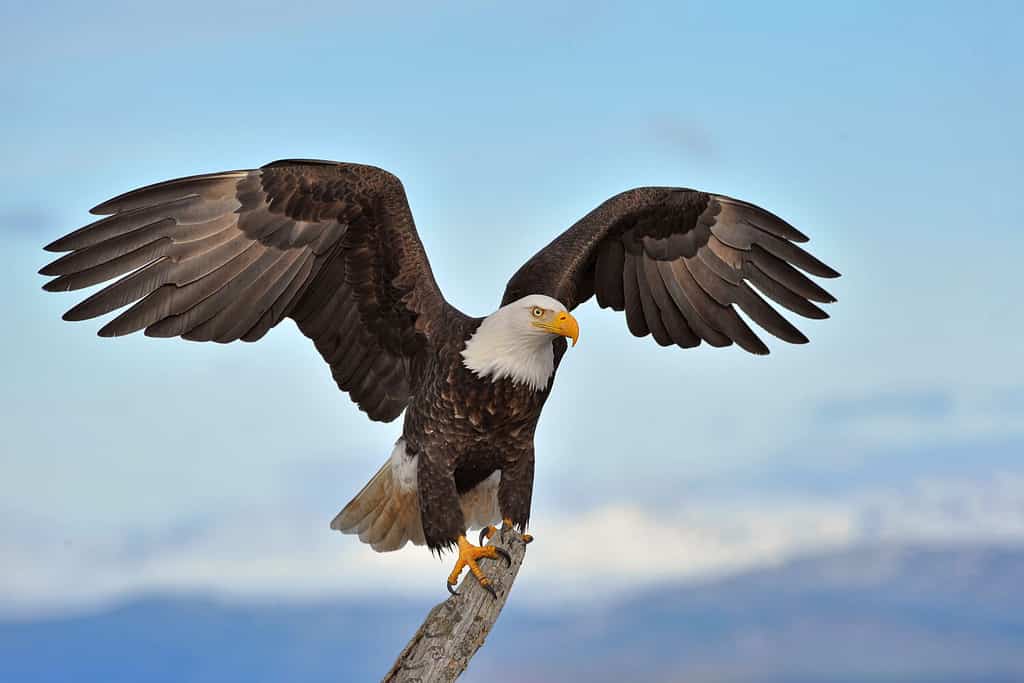
The diverse ecosystems along the Niagara River also sustain various protected animal species like the American Bald Eagle.
©FloridaStock/Shutterstock.com
- In 1996, the Niagara River Corridor earned recognition as an Important Bird Area (IBA). It became the world’s first internationally-recognized area of its kind. The river provides vital habitat for numerous wintering gull and waterfowl species, attracting thousands yearly.
- Within the lower Niagara River, the population of the endangered Lake Sturgeon, a fish species, finds a supportive environment. Its presence highlights the river’s significance for conservation efforts in New York State.
- The diverse ecosystems along the Niagara River also sustain various protected animal species. Notable examples include the Lake Sturgeon, Peregrine Falcon, and American Bald Eagle, all of which find refuge in these habitats.
- The Niagara River Gorge boasts an impressive array of flora, including 14 species of rare plants. Some plant species are classified as threatened or endangered, underscoring the importance of preserving this unique ecosystem.
- Goat Island, located within the Niagara Falls area, has significantly preserved native plant life. In 1901, 140 of 170 trees native to western New York were discovered thriving on Goat Island. This showcased its ecological significance.
- Over the past two centuries, researchers have documented over 600 plant species on Goat Island. This highlights its botanical diversity and ecological value.
- According to local legend, black squirrels were absent in Niagara Falls during the early 1800s. Back then, they resided across the river in Canada. However, with the construction of the first suspension bridge, it allowed them to cross into the United States. The truth of this tale remains uncertain. But, if you keep a keen eye during your visit to Niagara Falls, you might see a glimpse of these unique black squirrels.
The photo featured at the top of this post is © warasit phothisuk/Shutterstock.com
Thank you for reading! Have some feedback for us? Contact the AZ Animals editorial team.







